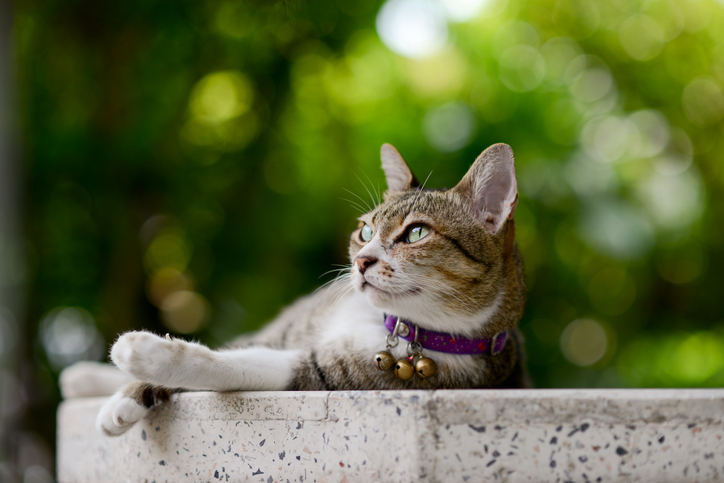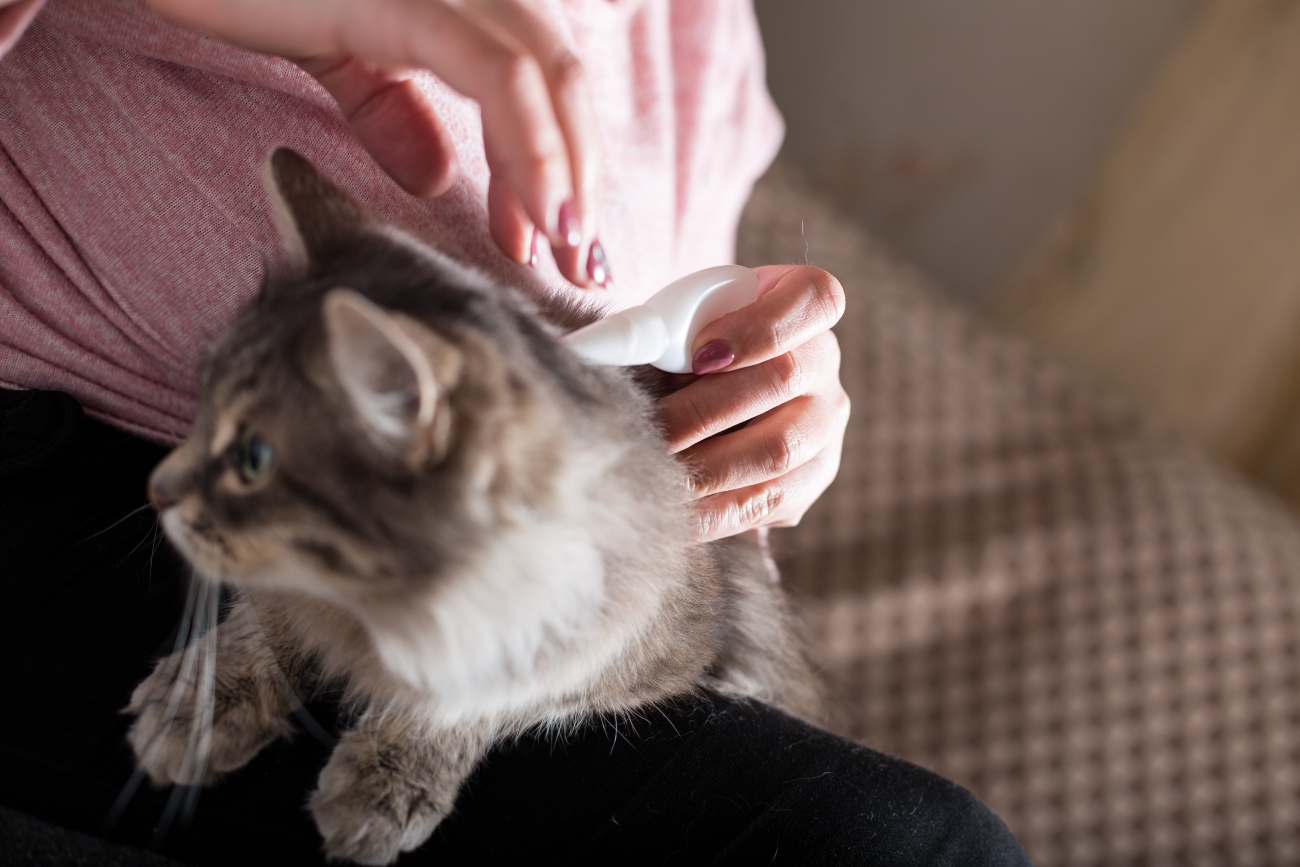How to get rid of fleas on your cat or dog
8th November, 2021

Flea infestations are one of the biggest fears of any pet parent. As well as ridding your poor cat or dog of the parasites themselves, you will need to clean your entire house, otherwise they will quickly start to set up home and reproduce – and they can give you a nasty bite, too!
Adult female fleas can lay as many as 50 eggs a day onto your unsuspecting pet. These will scatter around the house as your pet walks around, dropping off onto carpets and furniture. They hatch into larvae, develop into pupae and then grow into adult fleas, setting up home on your pet as the cycle starts all over again!
The majority of fleas will be in your home, rather than on your pet, so cleaning your entire home is essential if you find these little critters on your cat or dog.
The thought of thousands of fleas covering your house is a scary one! So, your best bet is to do everything that you can to ensure your pet doesn’t get infected in the first place.

Pet owners running the risk of a flea infestation
Despite how much of an annoyance fleas can be, many pet owners still aren’t taking all the precautions to protect themselves and their pet from the parasite, according to a survey by The Vet.
One in seven (14%) dog owners admit they do not treat their canine for flea and tick infestations, which equates to around 1.2 million animals.
By far the top reason given by dog owners for not protecting their pooch is: “My dog’s never had fleas or ticks so it’s really not necessary”.
However, dogs and cats can pick up fleas just from heading out to the garden, a local park, or a friend's house, The Vet points out.
Bethany Birch, Head Vet at The Vet veterinary surgery said: “It really is very simple – if you own a dog or a cat, you should be protecting your pet against fleas. They’re not just an inconvenience – these pests can cause major physical harm to both you and your pet in the worst-case scenarios.”
In a worst-case scenario, your pet could be required to go and see the vet – once they are safe to do so – which could involve them requiring a costly treatment to return them to full health. In such circumstances, if you are looking to make a claim, you need to make sure that your
Millions of pets could be carrying fleas
The Big Flea Project launched in 2018 with the aim of mapping the many flea species in the UK and discovering the diseases they carry.
In 2019, it carried out a large study of cats and dogs in the UK, in which they examined 1,475 pets for fleas. The findings showed that one in four cats and one in seven dogs sampled in the study were found to be carrying fleas.
It took some samples which were studied by the University of Bristol, and they showed that 11% of the fleas examined carried Bartonella, an infectious bacterium that can cause disease.
The lack of awareness around the prevalence and dangers of fleas among pet owners is alarming, said Richard Wall from the University of Bristol, who urged people to educate themselves on the parasites.
Research shows that not only do pet owners struggle to keep their pets flea-free, they also have issues with getting rid of the parasites once and for all. One in 10 pet owners say they have suffered up to three flea outbreaks, as per a previous survey by MSD Animal Health.
With it taking at least 12 weeks to break the flea infestation life cycle, short-term treatment is unlikely to end the outbreak – continuous protection is needed to successfully rid the pet of fleas.
Breaking the flea life cycle
Cats and dogs are always itching themselves – but if you notice they are irritated a bit more than usual, you should check for fleas, especially if they are chewing at themselves causing them to lose some of pet's fur.
However, some pets show no signs of fleas at all, which is why you need to inspect and groom them regularly.
Look for visible fleas (small, wingless parasites with thin bodies that range from brown to reddish-brown in colour) and flea faeces. Start your search on the lower back and base of the tail as this is where fleas like to congregate.
Once you’ve identified fleas on your pet, it’s time to quickly get to work. You want to kill fleas before their life cycle from an egg to an adult flea can be completed and an infestation develops.
There’s no way of telling how long the flea life cycle will take – it can be as little as 12 to 14 days or as long as 180 days, but usually takes about three to six weeks in a typical household.
Acting quickly also helps protect your pet from the nastier effects of fleas, such as:
An allergic reaction
Some animals are hypersensitive to flea saliva. Cats, for example, may show signs of hair loss or small scabs on their tail or along their neck if they have fleas. This can be called Flea Allergy Dermatitis.
Fleas feeding on blood
This can leave some pets – particularly young or frail animals – weak or even fighting for their life.
Flea larvae becoming infected with tapeworm eggs
If your pet then goes on to consume an infected flea while grooming themselves, it can become host to this parasite.
As long as you act quickly, the prognosis for your pet is usually pretty good. But, as the reinfestation stats show, you’ve got to be thorough.

What flea treatment should you use?
The first thing you need to do is remove all fleas from your pet as far as possible. You should be able to find a suitable flea treatment for your pet from a simple search online, but if you’re unsure then speak to your vet or call the 24-Hour Purely Pets Helpline for policyholders.
Many products are designed to kill adult fleas on the pet as well as larvae in the home, meaning if you have an infestation of fleas living in your carpets, you’ll be stopping them in their efforts to reproduce.
There are many flea treatments available from powders to tablets – your vet will be able to suggest the most appropriate one for your animal.
Before applying a flea powder, spray or spot-on treatment to your pet, however, you might want to give them a flea bath. Obviously, not all cats are up for getting wet and soapy, but most dogs will be fine with it, especially if you’ve made a weekly or monthly bath part of their normal routine.
Wash your pet like you would on any other occasion, except this time you will want to wash your dog with an appropriate flea shampoo.
If you have a puppy, make sure there is nothing in the shampoo that is going to harm them (there should be a minimum age on the bottle). Follow the instructions for proper dosage and usage.
You will want to be as thorough as possible with the clean, so you should think about getting some eye lubricant ointment or mineral oil to put in your dog's eyes to protect them from the chemicals in the shampoo. Flea shampoo tends to be harsher than regular dog shampoo. Use gloves to protect your hands from the chemicals, too.
Once you’re happy that you’ve done as much as you can to rid your dog of fleas, thoroughly rinse their coat with lukewarm water. After getting them out of the bath, your dog will want to shake off the excess water from their coat. Once they’re done shaking, dry your dog off with towels.
For cats that won’t go near a bath, a spray bottle can still do a good job of drowning the fleas – lightly spray your cat with water, then run a flea comb through the hair. Any fleas which are combed out should be put into a solution of water and dish soap to prevent them from jumping back onto your pet.
With your pet as clean as they can be, apply your chosen flea treatment, following the instructions to the letter. Although some treatments promise to kill the fleas on your cat in a matter of hours, for complete eradication, you might need to reapply it for a few days, as per the instructions.
How does a flea collar help?
Flea collars are a highly effective way of protecting dogs and cats from flea or tick infestation. They’re convenient, too, as they usually offer long-lasting protection for months at a time.
Some collars have the active ingredients on the outer surface. While they often do their job, sometimes the ingredient isn’t released consistently, and they may become less effective over time.
The newer collars have the active ingredients embedded or impregnated within the collar itself, which are released when the collar comes into contact with your pet’s skin and coat, spreading throughout your pet’s skin and providing an invisible layer of protection.
You can get flea collars for both cats and dogs. But, remember they won’t last a lifetime and will need replacing at least once a year. Flea collars will usually kill fleas almost as soon as they land on your pet – they also kill flea larvae, helping to break the flea life cycle.
Treating your home
With your pet on their way to becoming free from fleas, it’s time to treat your home. This could take a while…
The obvious places to start are where your pet sits frequently. But you will need to cover everywhere with the vacuum cleaner – even down the side of the sofa as flea eggs might be sitting dormant ready to hatch at a later date. If there was ever a time to go a little crazy with the vacuum, this is it!
If you’ve got access to a steamer, give your upholstery and carpets a once over with it to help ensure fleas are destroyed at all their life stages.
Then stick everything that’s washable in the washing machine: sheets, pet bedding, pillows and so on.
However, sometimes washing and vacuuming is just not enough. If you’ve got a big infestation on your hands, you should use an insecticide and acaricide household spray which will kill fleas, flea eggs and flea larvae, and continue to work for up to six months. Spray underneath furniture where fleas and their eggs might be hiding.
If you still think you have fleas after doing all of the above, your next step is to call a professional exterminator – some people like to do this anyway for peace of mind. A pro will get rid of the fleas once and for all!

Pet insurance from Purely Pets
All being well, you will exterminate your flea problem without your pet suffering from a serious health issue. But there’s no way of telling how they will react to being infested with fleas, which is why it’s so important that you have pet insurance in place.
Pet insurance may cover you should your cat or dog need any treatment beyond normal flea prevention and medication.
At Purely Pets, we make it easy for pet owners looking to take out pet insurance. We know it can be a bit of a minefield with all the different types, which is why we only offer one simple type – Lifetime cover.
Lifetime cover means that your pet will be protected throughout its years with you. Before deciding which type of pet insurance cover is right for you, it’s always worth getting a few quotes. Purely Pets can provide you with an online quote in just a few clicks.
Benefits of choosing pet insurance through Purely Pets include:
-
24-Hour Vet Helpline
-
Excess from £60
-
Online customer policy management
Get a quote for pet insurance today.
Helpful Pages
Recent Posts
Pet Insurance Quote
- 98% claims paid *
- Claims paid directly to vets
- 24/7 vet video consultations
- Interest free monthly payments




